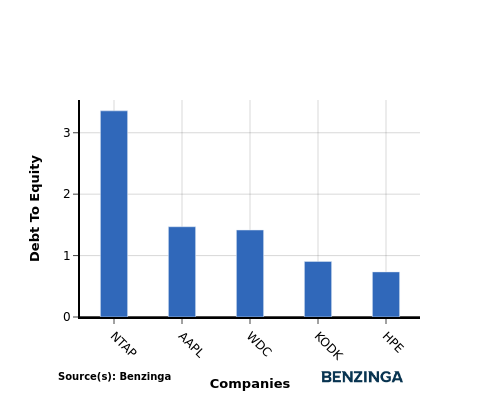Evaluating Apple Against Peers In Technology Hardware, Storage & Peripherals Industry
In today's rapidly changing and highly competitive business world, it is vital for investors and industry enthusiasts to carefully assess companies. In this article, we will perform a comprehensive industry comparison, evaluating Apple (NASDAQ:AAPL) against its key competitors in the Technology Hardware, Storage & Peripherals industry. By analyzing important financial metrics, market position, and growth prospects, we aim to provide valuable insights for investors and shed light on company's performance within the industry.
Apple Background
Apple is among the largest companies in the world, with a broad portfolio of hardware and software products targeted at consumers and businesses. Apple's iPhone makes up a majority of the firm sales, and Apple's other products like Mac, iPad, and Watch are designed around the iPhone as the focal point of an expansive software ecosystem. Apple has progressively worked to add new applications, like streaming video, subscription bundles, and augmented reality. The firm designs its own software and semiconductors while working with subcontractors like Foxconn and TSMC to build its products and chips. Slightly less than half of Apple's sales come directly through its flagship stores, with a majority of sales coming indirectly through partnerships and distribution.
| Company | P/E | P/B | P/S | ROE | EBITDA (in billions) | Gross Profit (in billions) | Revenue Growth |
|---|---|---|---|---|---|---|---|
| Apple Inc | 32.74 | 46.99 | 7.98 | 37.11% | $32.25 | $44.87 | 5.08% |
| Super Micro Computer Inc | 28.92 | 4.98 | 1.55 | 1.72% | $0.14 | $0.44 | 19.48% |
| Hewlett Packard Enterprise Co | 19.57 | 1.12 | 0.86 | -4.4% | $0.87 | $2.17 | 5.87% |
| Western Digital Corp | 22.78 | 4.48 | 1.50 | 5.86% | $0.28 | $0.91 | 30.94% |
| NetApp Inc | 18.37 | 20.07 | 3.31 | 33.42% | $0.43 | $1.19 | 3.84% |
| Pure Storage Inc | 144.32 | 14.41 | 5.79 | -1.1% | $0.04 | $0.54 | 12.26% |
| Eastman Kodak Co | 13.94 | 0.96 | 0.58 | -1.66% | $0.02 | $0.05 | -0.8% |
| Turtle Beach Corp | 17.58 | 2.17 | 0.72 | -0.55% | $0.0 | $0.02 | 14.42% |
| Average | 37.93 | 6.88 | 2.04 | 4.76% | $0.25 | $0.76 | 12.29% |
Upon closer analysis of Apple, the following trends become apparent:
-
The Price to Earnings ratio of 32.74 is 0.86x lower than the industry average, indicating potential undervaluation for the stock.
-
With a Price to Book ratio of 46.99, which is 6.83x the industry average, Apple might be considered overvalued in terms of its book value, as it is trading at a higher multiple compared to its industry peers.
-
The Price to Sales ratio of 7.98, which is 3.91x the industry average, suggests the stock could potentially be overvalued in relation to its sales performance compared to its peers.
-
The Return on Equity (ROE) of 37.11% is 32.35% above the industry average, highlighting efficient use of equity to generate profits.
-
The Earnings Before Interest, Taxes, Depreciation, and Amortization (EBITDA) of $32.25 Billion is 129.0x above the industry average, highlighting stronger profitability and robust cash flow generation.
-
Compared to its industry, the company has higher gross profit of $44.87 Billion, which indicates 59.04x above the industry average, indicating stronger profitability and higher earnings from its core operations.
-
The company's revenue growth of 5.08% is significantly lower compared to the industry average of 12.29%. This indicates a potential fall in the company's sales performance.
Debt To Equity Ratio

The debt-to-equity (D/E) ratio is an important measure to assess the financial structure and risk profile of a company.
Considering the debt-to-equity ratio in industry comparisons allows for a concise evaluation of a company's financial health and risk profile, aiding in informed decision-making.
By evaluating Apple against its top 4 peers in terms of the Debt-to-Equity ratio, the following observations arise:
-
Apple holds a middle position in terms of the debt-to-equity ratio compared to its top 4 peers.
-
This indicates a balanced financial structure with a moderate level of debt and an appropriate reliance on equity financing with a debt-to-equity ratio of 1.47.
Key Takeaways
For Apple in the Technology Hardware, Storage & Peripherals industry, the PE, PB, and PS ratios indicate that the stock is relatively undervalued compared to its peers. However, the high ROE, EBITDA, gross profit, and low revenue growth suggest that Apple is efficiently utilizing its resources and generating strong profits, despite slower revenue growth. Overall, Apple's financial performance is solid, with room for potential growth in the future.
This article was generated by Benzinga's automated content engine and reviewed by an editor.
Posted-In: BZI-IANews Markets Trading Ideas



